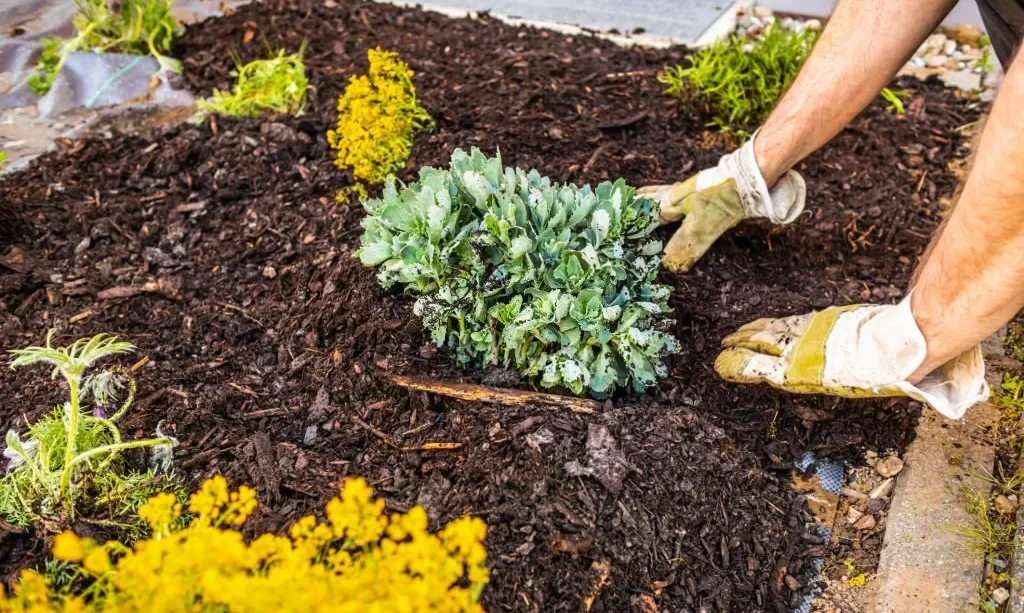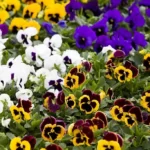Mulch is a gardener’s best friend, providing numerous benefits like weed suppression, moisture retention, and soil insulation. However, for mulch to work its magic effectively, it needs to stay in place. A garden covered in scattered mulch not only looks untidy but also loses the many advantages mulch offers. In this article, we’ll explore the art of keeping mulch in place, ensuring that your garden remains a neat and well-maintained oasis. From proper mulch application techniques to choosing the right mulch material, we’ll share practical tips that will help you enjoy all the benefits of mulch without the frustration of it constantly shifting or blowing away.
- Derived from the shell of the cocoa bean, natural dark, fade resistant color and pleasing cocoa aroma
- Very lightweight and easy to spread
- Helps to smother weeds and retain moisture in your light soils
- Will not burn vegetation
- Speeds soil warm-up in the spring and protects perennial root structures
Proper Mulch Application
The foundation for keeping mulch in place begins with its proper application:
- Optimal Depth: One of the key factors in mulch stability is the depth at which it’s applied. Aim for a thickness of 2 to 4 inches. This depth not only provides excellent weed suppression and moisture retention but also helps prevent mulch from being easily dislodged by wind or rain.
- Even Spreading: When applying mulch, take care to distribute it evenly. Avoid creating clumps or mounds, as uneven mulch piles are more likely to shift or scatter. Raking the mulch after spreading it can help achieve a smoother and more consistent surface.
- Regular Replenishment: Mulch naturally decomposes over time, so it’s essential to replenish it periodically. By maintaining the proper mulch depth, you ensure that its benefits remain intact, and it continues to serve as an effective ground cover.
Choose the Right Mulch Material
Selecting the right mulch material is another critical aspect of keeping mulch in place:
- Organic vs. Inorganic: Mulch materials can be categorized as organic or inorganic. Organic mulches, such as wood chips or straw, tend to be heavier and stay in place better than lightweight materials. Inorganic options like rubber or stone mulch have their advantages but may require more attention to prevent scattering.
- Consider Local Climate: The choice of mulch material should take your local climate into account. Some mulches may be better suited to windy areas or regions with heavy rainfall. Consider the environmental conditions in your area when selecting mulch materials.
- Garden Needs: The type of garden you have and your specific needs should also influence your mulch choice. For example, some mulches may be better for ornamental flower beds, while others are ideal for vegetable gardens. Choose a mulch material that aligns with your gardening goals.
By following these guidelines for proper mulch application and selecting the right mulch material, you’ll be well on your way to maintaining a garden that not only looks tidy but also reaps the full benefits of mulch’s protective and nurturing qualities. In the following sections, we’ll delve into additional strategies and techniques to keep mulch firmly in place, ensuring your garden remains a source of beauty and tranquility.
- Scotts best mulch
- Color Guard keeps color lasting all year
- Apply around trees, shrubs, flowers, or vegetables after seeds have germinated and plants have developed
Mulch Edging and Borders
Creating well-defined edges and borders around mulched areas is an effective strategy for keeping mulch neatly in place:
- Edging Materials: Utilizing various edging materials, such as metal, plastic, bricks, or natural elements like rocks or logs, can establish clear boundaries for mulch. These edging materials serve as physical barriers that help contain the mulch and prevent it from spilling onto walkways, driveways, or lawns.
- Installation: Proper installation of mulch edging involves digging a shallow trench along the edge of the mulched area and placing the chosen border material securely. Ensure that the border stands slightly above the ground to prevent mulch from escaping.
- Maintenance: Regularly inspect and maintain your mulch edging. Over time, it may require adjustments or minor repairs due to shifting or settling. Properly maintained mulch edging not only keeps the mulch in place but also adds a polished and organized look to your garden.
- Kit contains (1) 100 ft. coil of 1.5 in. tall landscape edging and (32) anchoring spikes
- Easily makes curves and straight sections in DIY landscaping projects
- Made of flexible & durable recycled plastic
- Suitable for all soil types
- Quick & simple installation, no digging required
Windbreaks and Wind-Resistant Plants
When dealing with windy conditions, incorporating windbreaks and wind-resistant plants can significantly enhance mulch stability:
- Windbreaks: Planting windbreaks like shrubs, tall grasses, or small trees in strategic locations can create a barrier that reduces the impact of strong winds on your garden. Windbreaks act as natural shields, protecting your mulch from being blown away.
- Selection of Wind-Resistant Plants: Choose wind-resistant plants that can serve as natural wind barriers. These plants should have sturdy stems and dense foliage that can withstand the force of the wind. Examples include ornamental grasses, juniper, or arborvitae.
- Spacing and Placement: When planting windbreaks or wind-resistant plants, consider their spacing and placement. Properly spaced and strategically positioned windbreaks can help deflect and slow down wind, minimizing its effect on the mulch.
Mulch Mats and Fabric
Mulch mats or landscape fabric offer an alternative solution to keep mulch in place:
- Mulch Mats: Mulch mats are pre-cut or custom-sized mats made of materials like rubber or plastic. They are placed on the ground before applying mulch and act as a barrier between the mulch and the soil. Mulch mats help prevent mulch from direct contact with the soil, reducing weed growth and improving mulch stability.
- Landscape Fabric: Landscape fabric is a woven or non-woven material that can be used beneath mulch to keep it in place. It serves as a weed barrier while allowing water to penetrate the soil. Landscape fabric can be particularly useful in areas prone to erosion or heavy rain, as it helps hold mulch in position even during downpours.
- Installation: Properly installing mulch mats or landscape fabric involves laying them down before mulch application. Secure the edges of the material to keep it in place. Be sure to cut holes or slits in the fabric to accommodate existing plants or newly planted ones.
These strategies, whether using mulch edging and borders, windbreaks, wind-resistant plants, or mulch mats and fabric, provide effective ways to ensure that your mulch remains where it belongs—keeping your garden both beautiful and functional. In the upcoming sections, we’ll explore additional methods and tips to maintain the integrity of your mulch cover, so you can enjoy the many benefits it brings to your garden.
- PERMANENT MULCH: Harmiden recycled rubber mulch roll provides the beauty and look of natural mulch PLUS the superior weed control benefits. Moreover, it is a soft cushion to kneel down and walk on.
- HIGH-QUALITY MATERIAL: Made of one hundred percent recycled rubber tires, this rubber mulch for landscaping blocks weeds, yet still allows water, air and nutrients reach. Backing included for extra weed blocking.
- MAINTENANCE FREE: No yearly messy and expensive re-mulching, alternative to traditional mulch, this rubber mulch mat won’t scatter or float, staying in place for years to come and withstanding all seasons.
- WIDE APPLICATION: This recycled rubber mulch can be used between raised garden beds, in muddy areas, around patios and pathways, under downspouts, around pools, in outdoor play areas, in high drainage areas and more.
- EASIEST INSTALLATION: Just roll out where desired. This recycled rubber walkway can be easily cut and shaped for many uses to increase beauty of your outdoor space.
Topdressing with Compost or Soil
Another strategy to enhance mulch stability and improve your garden’s overall health is topdressing with compost or soil:
- Topdressing Purpose: Topdressing involves adding a thin layer of compost or soil over the existing mulch. This layer serves multiple purposes, one of which is anchoring the mulch in place. The added weight of the topdressing material helps keep the mulch from scattering.
- Nutrient Boost: Compost or soil topdressing not only aids in mulch retention but also provides additional nutrients to the soil beneath. As the topdressing material gradually breaks down, it enriches the underlying soil, promoting healthier plant growth.
- Frequency: The frequency of topdressing can vary depending on your garden’s needs. Consider topdressing after initially mulching and periodically throughout the growing season to maintain mulch stability and soil fertility.
Mulch Maintenance
Regular mulch maintenance is essential for keeping it in place and preserving its effectiveness:
- Raking and Fluffing: Periodically rake and fluff the mulch to prevent compaction. Compacted mulch is more likely to shift or become less effective. Raking also helps distribute the mulch evenly and refreshes its appearance.
- Inspect After Weather Events: After heavy rain, strong winds, or severe weather, inspect your mulched areas for signs of displacement or damage. Replenish mulch in areas where it has been disturbed or lost.
- Replenishment: As mulch naturally breaks down over time, be prepared to replenish it to maintain the desired depth. Regular replenishment ensures that mulch continues to provide its benefits.
Conclusion
Keeping mulch in place isn’t just about aesthetics; it’s about maximizing the advantages of mulch in your garden. Proper mulch application, the choice of appropriate materials, and the use of strategies like edging, windbreaks, and topdressing all play vital roles in ensuring your mulch remains where it belongs.
By following the guidance outlined in this article, you can create a garden that not only looks tidy and well-maintained but also functions at its best. Mulch that stays in place helps with weed control, moisture retention, soil insulation, and overall garden health. So, whether you’re a seasoned gardener or just starting, incorporating these strategies into your garden maintenance routine will ensure that your mulch remains a valuable asset, enhancing the beauty and productivity of your outdoor space.








